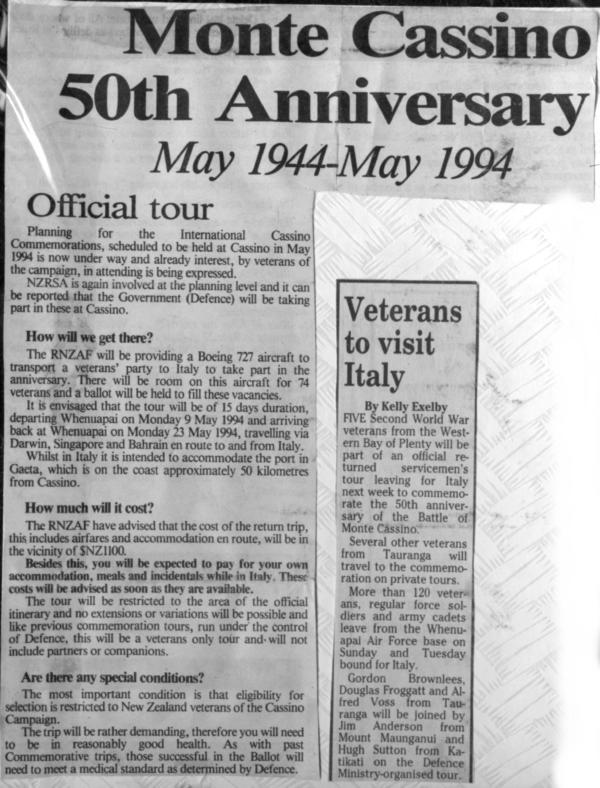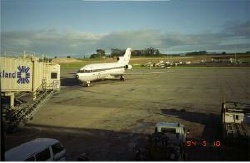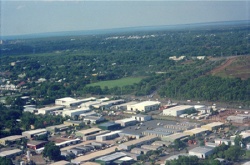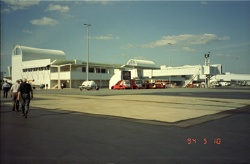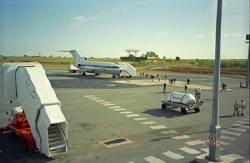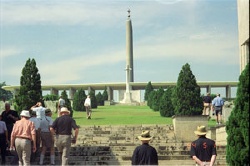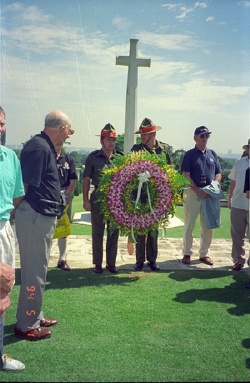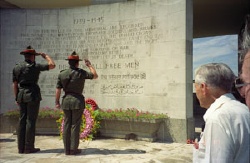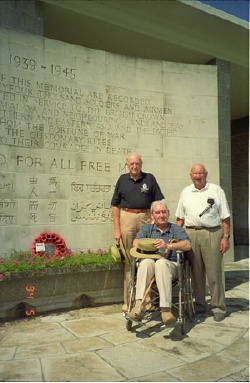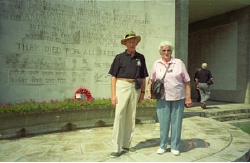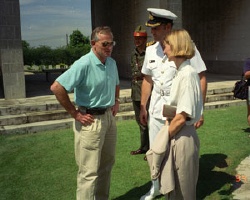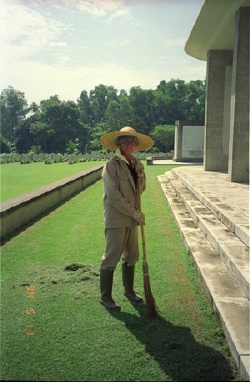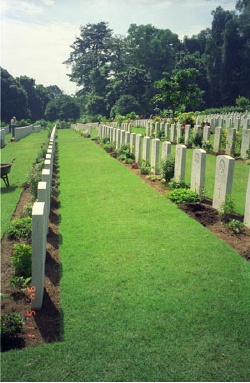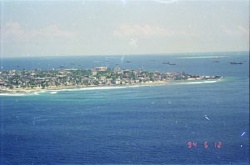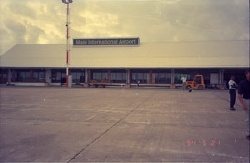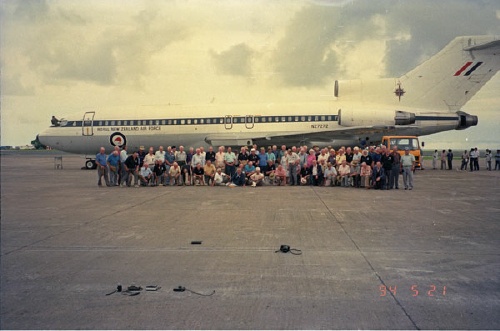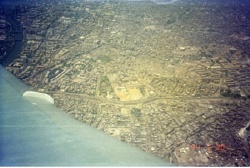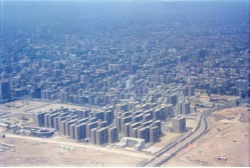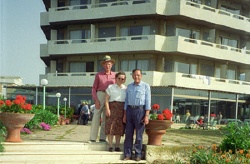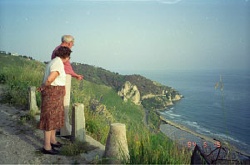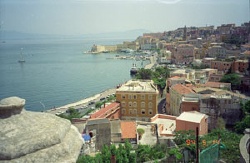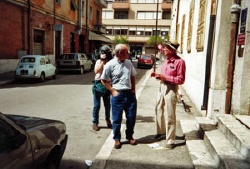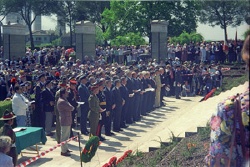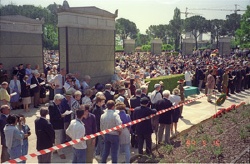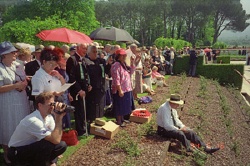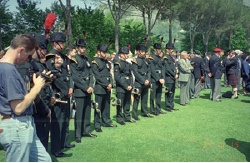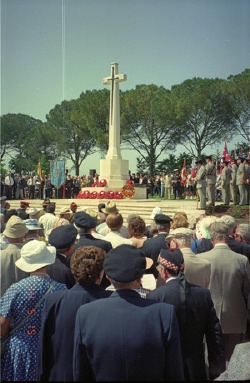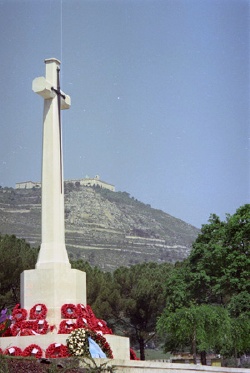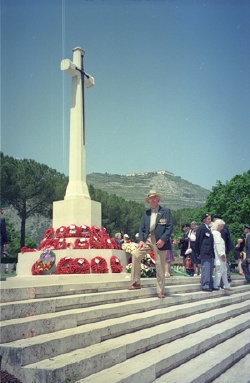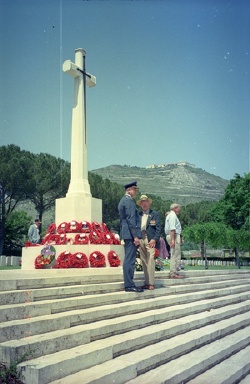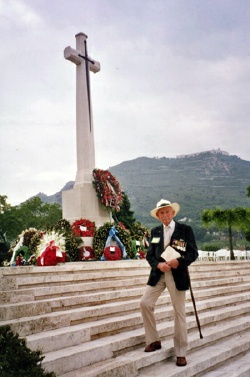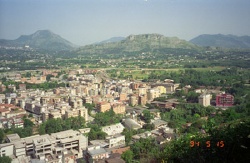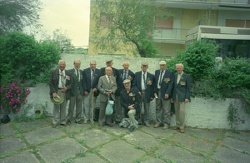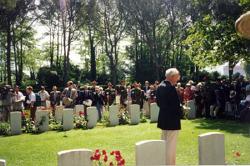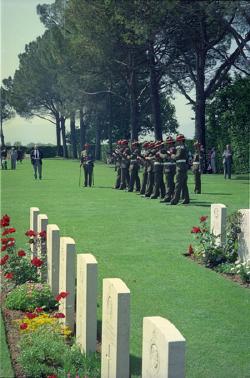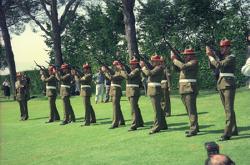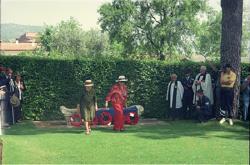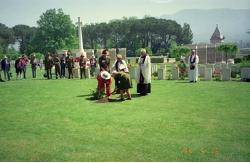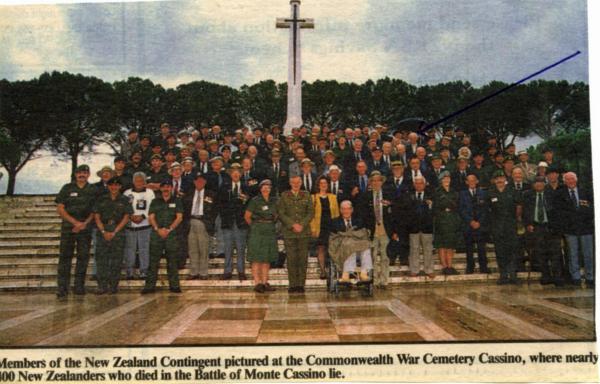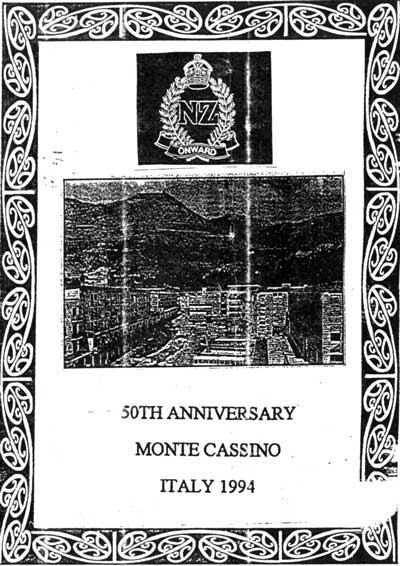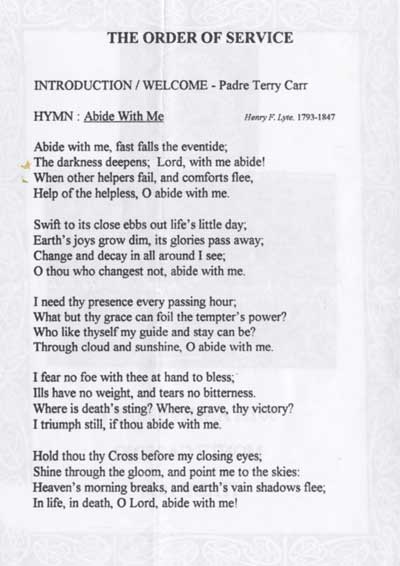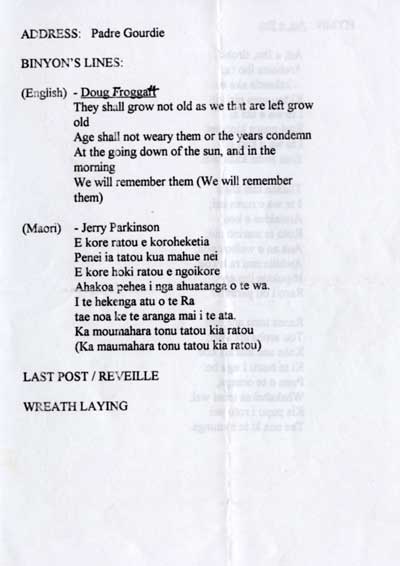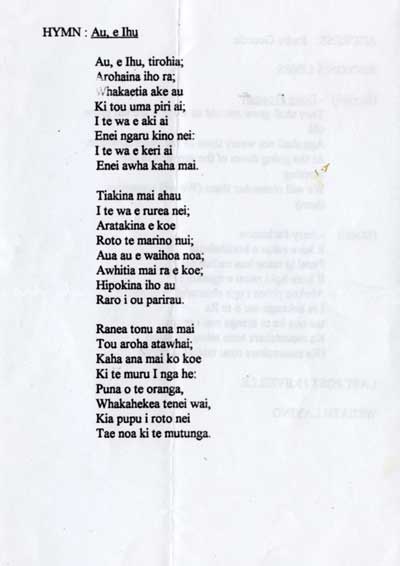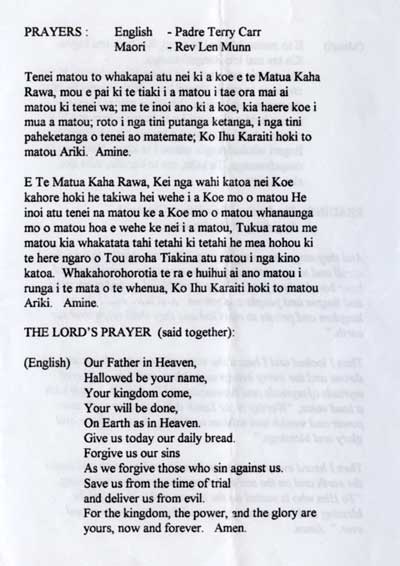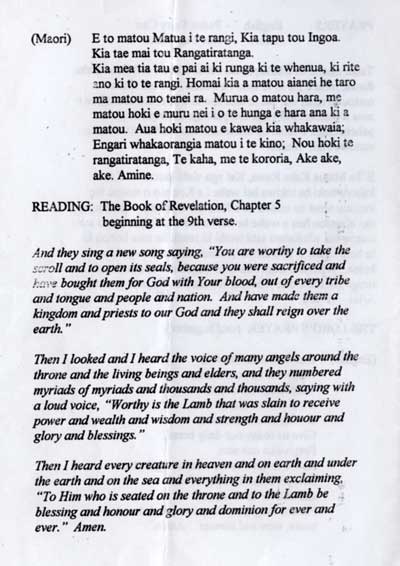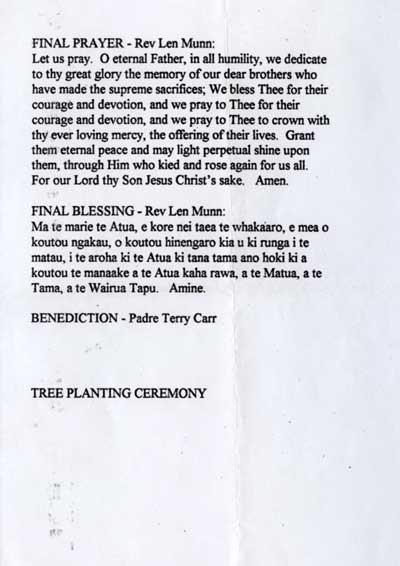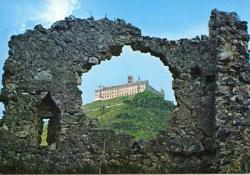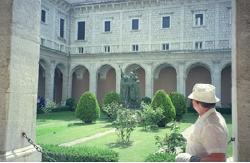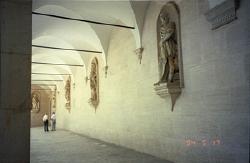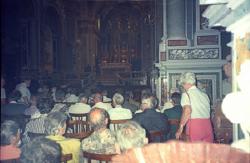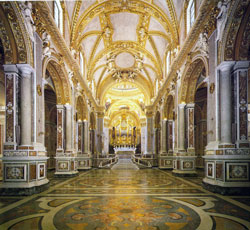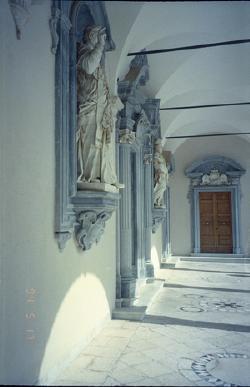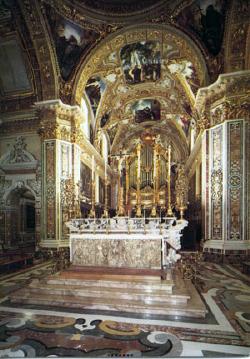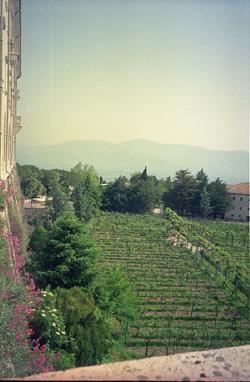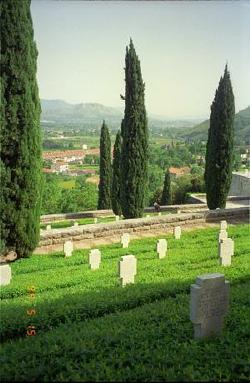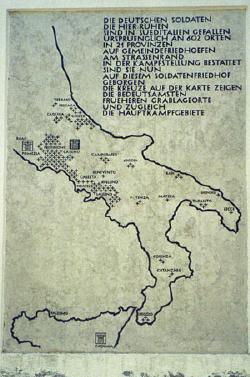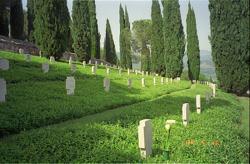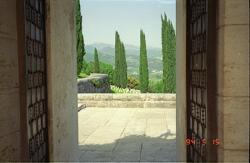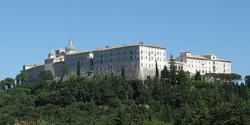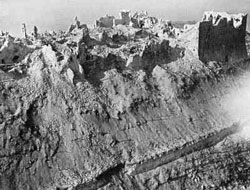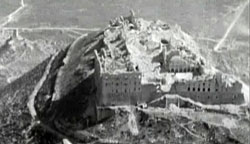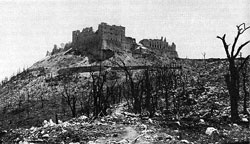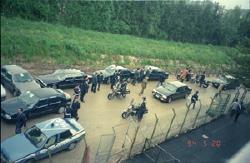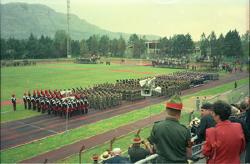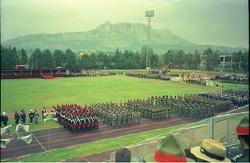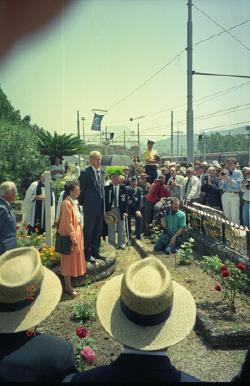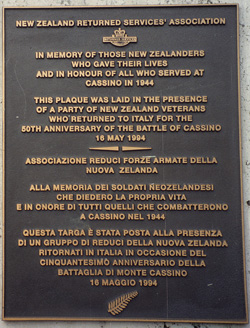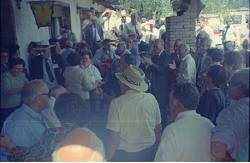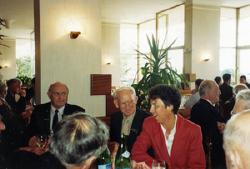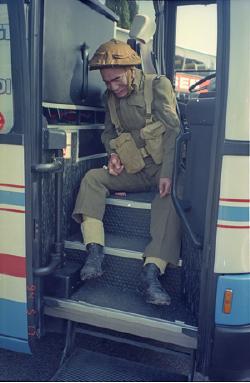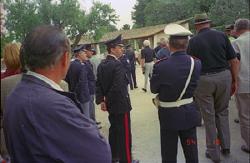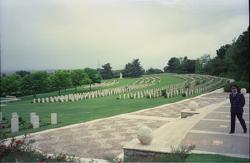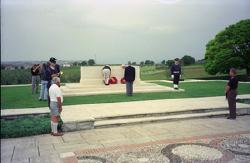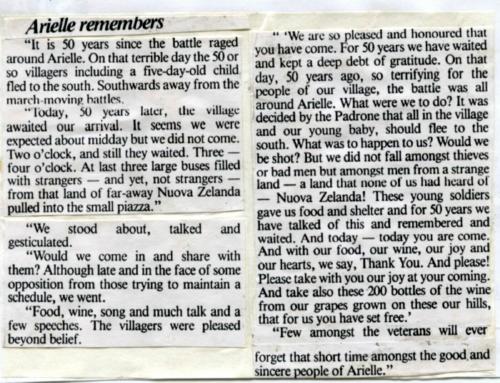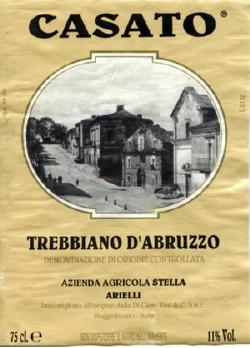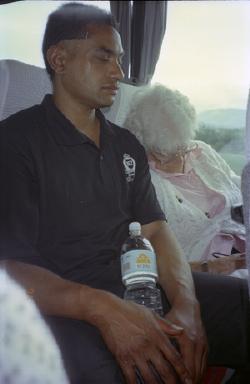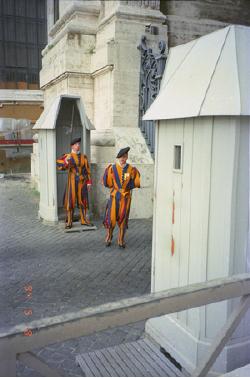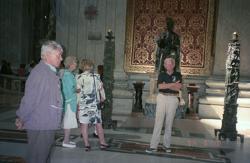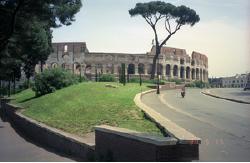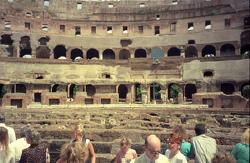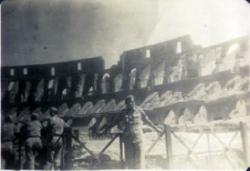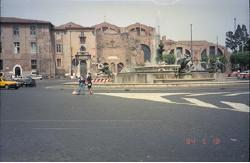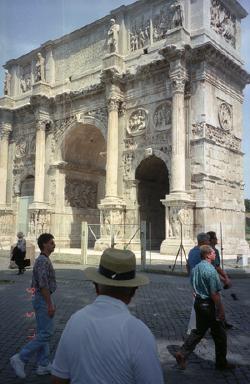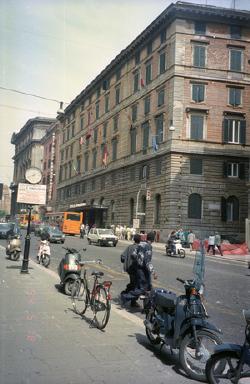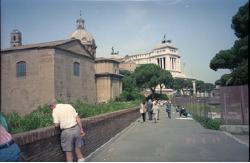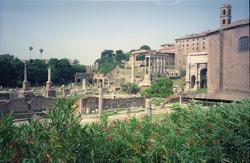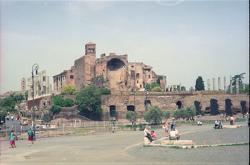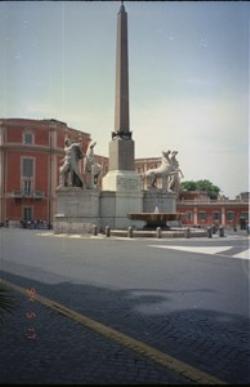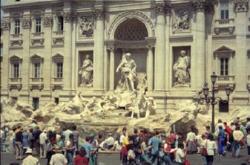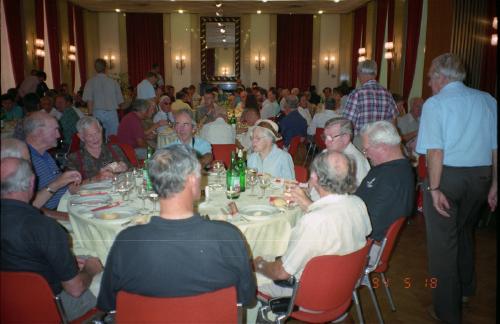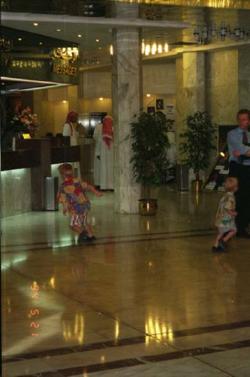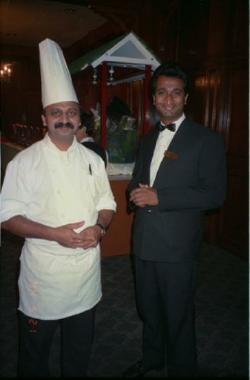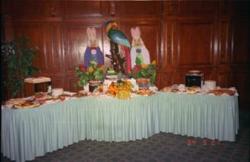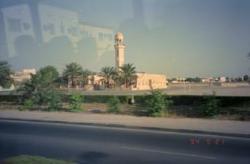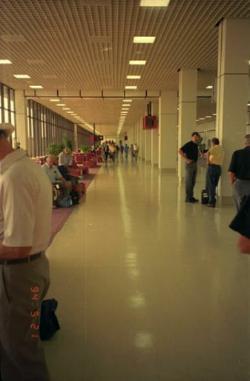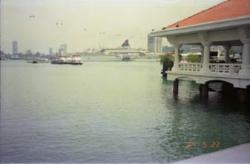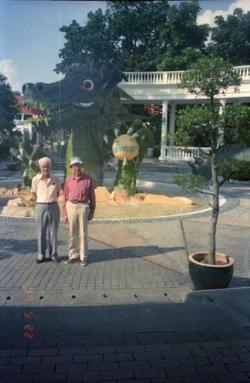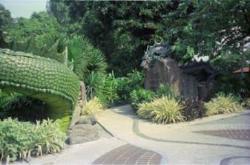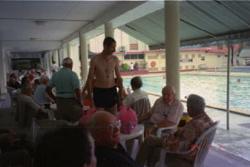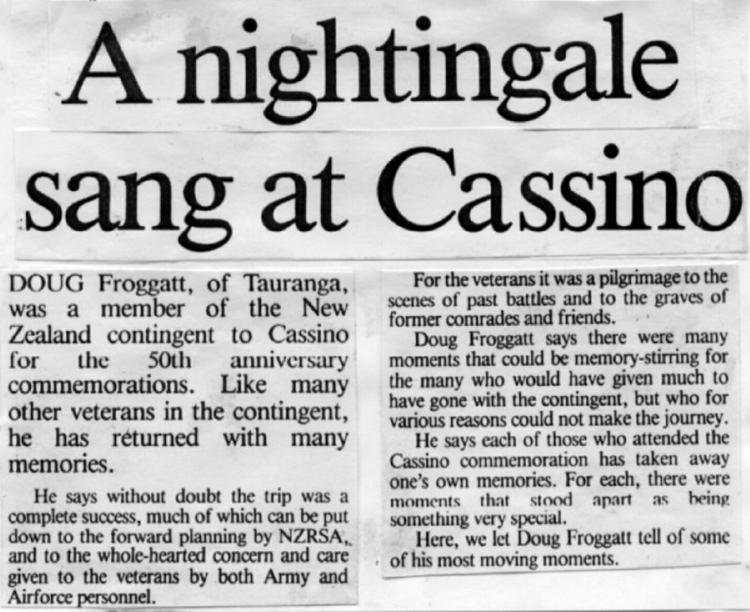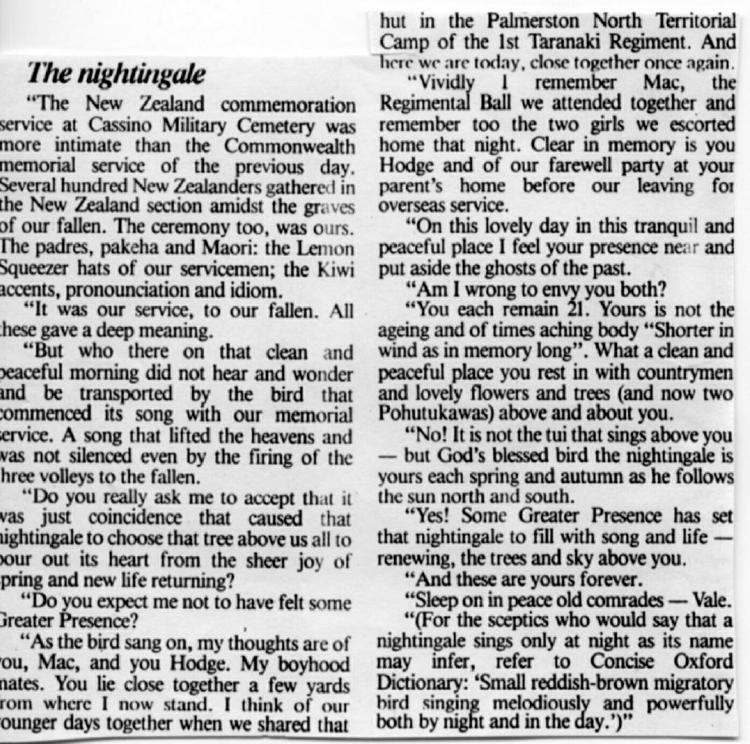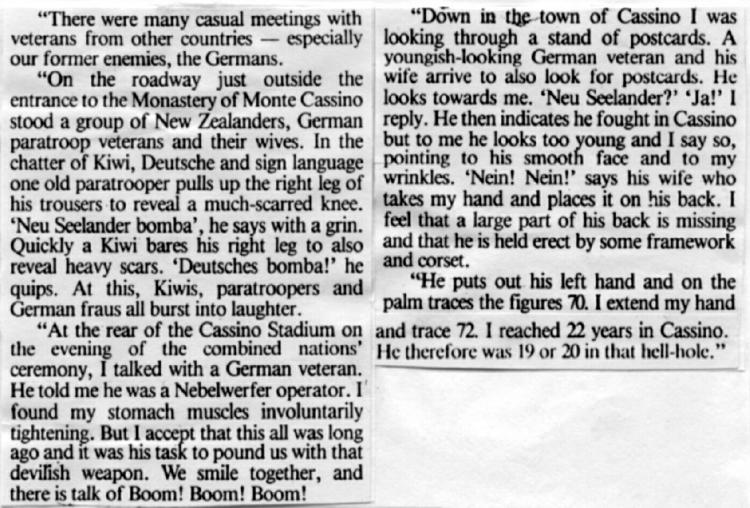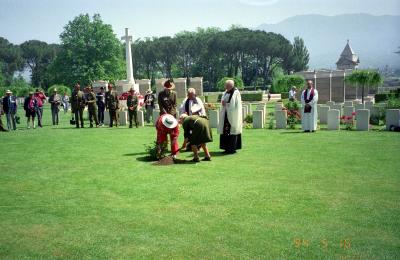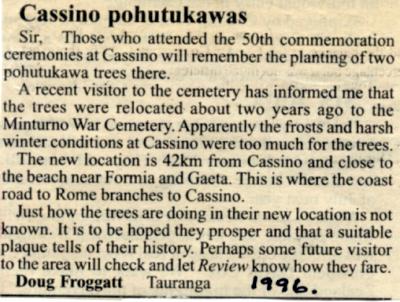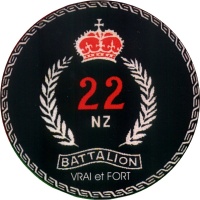
22nd Battalion 2NZEF
"Vrai et Fort"
Cassino 1994 - 50th Anniversary
Monte Cassino Fifty Years On
The years that have passed are of memories, that took old soldiers back over the sea,
Back to places of hard fought battles, in Roman lands that are now Italy.
Fifty years since death walked wide in that country, where comrades were cut down like hay,
Where one passed from youth to the starkness of manhood, through the scenes, deeds and deaths of a day.
Back again to the Sangro and Monte Cassino, where we shot and in turn were shot down by the Hun,
Now after 50 years as Veterans returning, to view over lands that were won.
But won at the cost of young life's blood, as graves set down in rows mutely proclaim,
In the folly and sadness that lingers; lives of survivors have been never the same.
There is peace now on Monte Cassino, a quiet place and pleasant to be,
Yet events long ago and so monstrous, are back vividly crowding on me.
Again there are five hundred aircraft: that sight still fills me with awe;
The roar of those thousand big motors, pounds deep in my brain cells once more.
Again the bomb-bays slide wide open, to let five thousand bombs tumble down,
Bombs to pound the sacred old Abbey, bombs to punish Cassino's old town.
Within sanctuary walls of the Abbey, that had stood firm for hundreds of years,
Two hundred souls knelt for Salvation, through prayer made more fervent by fears.
Known not to monks or penitent townsfolk, was their lot cast already by fate,
Through their prayers - to monks and to sinners - came the roar of those bombers - too late.
Fate's hand was played quickly that grey day, and Dark Angel Death held full sway,
Saintly monks and Monastery refuge, with the two hundred were blasted away.
Gone was the venerable Abbey, gone too those kneeling in prayer,
Gone was the town of Cassino, and the stench of scorched flesh filled the air.
Lives of Germans and Italians in thousands, along with the monks on that dome,
Lost in forfeit for a small town and its hilltop, that stood square in the pathway to Rome.
Streams again sunshine over Monte Cassino, stands a new town with new life at its feet,
The blithe nightingale welcomes the Springtime, whilst wild flowers young olive trees greet.
The Abbey like a phoenix has risen, "PAX" is inscribed over the door,
Novice monks toil amidst grapevines and poppies, then intone their devotions once more.
Everyone paid a steep price at Cassino, for death was the victor that day,
In the valleys below and on hillsides, in thousands the young soldiers lay.
Thirty thousand had passed into history, to add to a previous horde,
For the history of man down the ages, is a story of death by the sword.
Fifty years on and one is back as a veteran, armed only with thoughts of the mind,
To stand pensive amidst graveyards overflowing, with New Zealand's young men left behind.
Yet one's thoughts come the same where the Germans, in their thousands lie six in each bed,
Pray! who are the victors and who are the vanquished, when the young manhood of nations is dead?
Douglas Froggatt,
Cassino May 1994
|
The Battle for Cassino
The three battles for the hilltop of Cassino occupied the 5th Army
in Italy for many months and cost thousands of lives. Fortunately, the
22 Battalion had only a small part to play, at the end of the second
battle. General Mark Clark, the American in overall command of the 8th
Army invited General Freyberg and the New Zealand Division to have one
last attempt to take Cassino. The 22nd Battalion was kept in reserve,
being a highly mobile, motorised battalion its role was to sweep down
the Liri Valley towards Rome as soon as Cassino fell. Eventually it
became obvious that Cassino
would not fall, so Freyberg brought in the 22nd to bolster and relieve
his other battalions.
The 22 Battalion's HQ and 3 and 4 Companies moved into Cassino on
the night of 25 March 1944 to relieve companies of the 21 and 24
Battalions.
(See Battalion Diary for March 1944.) The Battalion was relieved by 3 Grenadier Guards on the night of 7 April 1944.
My father, Douglas FROGGATT, was one of the veterans chosen by
ballot to form the official party for the 50th commemoration. He
recorded the event in a photo album, but also in poems and a long
article published in the RSA Review. This is his story of the Cassino
50th Commemoration.
I won the ballot and was off to Italy
"I was one of 83 veterans to be balloted for the available places for the return to Cassino. The build-up to the event was long and tiring. Passports were checked, medical certificates examined and further information
requested. Travel insurance was mandatory. The trip to Italy was subsidised but each veteran had to pay his way. I was asked to contribute $2585. We were warned about Singapore - chewing gum, $500
fine; dropping cigarette butts, $500; not flushing toilets, $500; Ladies of the Night, "if you CAN.... DON'T!!" (after all, these are WW2 soldiers on this trip !!), and the only positive - "alcohol at the
Fernleaf Centre (the NZ Defence Force Mess) is Duty Free".
The flight to Rome was long, but we had several stops: Auckland to Amberley, Darwin, Singapore, Maldives, Bahrain, Cairo and Rome. Flight NGB 274 departed Auckland at 0900 on 10 May 1994 and landed in Rome at
1735 local time on 13 May. The overall Mission Commander was Wing Commander Graham Lintott (later to become Air Vice Marshall and Chief of the Air Force), and our Captain was SQN LDR Edwards. Overnight accommodation
was provided in Singapore and Bahrain."
|
RNZAF Boeing 727 prior to departure
|
From my seat looking towards the rear
|
We arrive over Darwin
|
|
Darwin Terminal from aircraft
|
Our aircraft from Terminal Building: Darwin
|
Kranji Military Cemetery: Singapore
|
|
Wreath Laying at Kranji
|
|
Ivan Gibbons, Ken Cameron and Ian Fraser (in chair)
|
|
Cath Hervey, war-time Nursing Sister and Doug at Kranji
|
Brig Dodson, NZ Naval Attache and Assistant Consul, Singapore
|
Gardener, Kranji War Cemetery
|
|
War Graves, Kranji Cemetery, Singapore
|
The largest of the Maldive Islands
|
Male. The Airport of the Maldive Islands |
|
The veteran's party at Male Airport
|
We arrive over Cairo
|
Cairo from the air
|
Italy - Rome, Gaeta, Cassino, and the Sangro
From Cairo the 727 flew on to Rome where we arrived on Friday 13
May. The next day was scheduled for a mix of local sightseeing and a
bus trip to Anzio. Instead of this, I was met at the hotel by my
old friend Hansrudi Lauper, who had driven down from Berne with his
wife just to meet me in Rome. We spent the Saturday driving along the
coast from Rome to Naples. Sunday was the Commonwealth Ceremony at
Cassino,
and the Monday was the New Zealand ceremony there.
|
Myself and the Laupers outside Hotel Torre del Sole, Terracina, Italy |
Denise and I on the coast between Rome and Naples |
Gaeta |
|
The Cathedral at Gaeta |
Myself, Denise and Hansruedi outside Gaeta Cathedral
|
On to Cassino and being interviewed in the streets of Cassino by Television New Zealand |
|
Commonwealth Commemoration Service |
Cassino War Cemetery, 15 May 1994
|
Cassino War Cemetery
|
|
Commemoration Service
|
Wreath laying: Cassino War Cemetery |
Commonwealth Cenotaph: Monte Cassino Monastery in background |
|
Doug Froggatt at the Cross of Sacrifice, Cassino 15 May 1994
|
The senior British Air Force Officer stops to chat
|
Myself before the Cross again. This time it was May 2004 and I back again for the 60th Commemoration |
|
In between my two visits the Cross was destroyed by lightning on 7 October 1998 |
The new Cassino with Monte Trocchio centre rear
|
Members of the 22nd Battalion at Cassino 1994.
Back (L-R) Ken Cameron; Colin Thompson; Ian Fraser; Noel Bird; Ron Morrision; Pat Beachen; Mick Condon; Doug Froggatt.
Front: Hugh Nairn; Owen Bullot |
|
The New Zealand Commemoration Service at Cassino, 16 May 1994
|
I recite the Ode "They grow not old..."
|
The New Zealand Firing Party
|
|
Salute the dead with a 3 round volley
|
Our two war-time Nursing Sisters lay a wreath and...
|
plant a Pohutukawa tree, 16 May 1944
|
|
The New Zealand contingent as seen in the RSA Review. Doug Froggatt in the back row (arrow)
|
New Zealand Commemoration Service
The Monastery at Cassino
The Monastery, high on the hill overlooking the town of Cassino, loomed large in the minds of the Allied troops who were bogged down in the town. At tremendous cost the Monastery was bombed and destroyed.
Although this act raised the spirits of the infantry, it did not aid in the capture of the town. After the war the Allies rebuilt the Monastery and today it remains an important site of Remembrance.
|
The Monastery as seen through the ruins of the town
|
Views inside the rebuilt Monastery of Monte Cassino
|
Views inside the rebuilt Monastery of Monte Cassino
|
|
The Cloisters
|
A service in progress in the Monastery Chapel
|
|
|
The Cloisters
|
The Presbytery
|
The Monastery vineyard from the upper walls
|
|
The Polish War Cemetery. Over 3,000 are buried here
|
The German War Cemetery, Cassino. 20,057 are buried here. Six are in each grave.
|
Map on the Chapel wall of German Cemetery
|
|
German War Graves
|
Entrance to the German Cemetery
|
the Monastery of Monte Cassino today
|
|
The Monastery after the bombing in 1944
|
|
|
The International Service at Cassino
Following the New Zealand and Commonwealth services was the large international commemoration. It was held at the local sports stadium, and attended by the President of Italy.
|
Police escort for President of Italy to the All Nations Commemoration Service
|
Italian forces on parade. Monte Trocchio in rear
|
All Nations commemoration parade and service: Cassino Stadium
|
|
All Nations commemoration parade and service: Cassino Stadium
|
NZ Minister of Defence Warren Cooper unveils plaque at Cassino Railway Stadium
|
Photo of the plaque in the RSA Review
|
|
Poles give an impromptu display of dancing and singing during a lunch break at Cassino
|
Young Maori soldiers of our party give an impromptu haka in reply
|
Ivan Gibbons and Doug Froggatt with the Italian lady interpreter
|
|
This dummy figure of an NZ wartime soldier was "Guard" on one of our buses and caused much amusement to German veterans. Note decapitated finger on step
|
Views from the heights of Orsogna and looking towards the route taken by the NZ Division in its advance. Lanciano, Castelfrentano, Guardiagrele and San Eusanio are visible
|
|
|
Police at the entrance to the Sangro Military Cemetery. Police were our security group in Italy.
|
Sangro River Commonwealth Military Cemetery. Many New Zealanders lie here
|
Wreath laying at Sangro River Cemetery
|
|
Arielle Remembers. We arrived late in the day to a wonderful welcome
|
|
The Town Clerk opens another bottle
|
The label from the bottle I took home and enjoyed at Christmas
|
It had been a long day for our nursing sister and a young soldier
|
Rome: Back again after 50 years
From Cassino we moved north to Rome. I had been here 50 years ago after the city had been liberated by General Mark Clark.
|
Swiss Guards, Vatican
|
St Peter's Church, Vatican City, taken on my first visit in 1944
|
The Boys on the steps of St Peter's, 1944
|
|
St Peter's in the Vatican
|
I stand on the steps of St Peter's
|
Inside St Peter's before his statue
|
|
The Colosseum: Rome
|
Inside the Colosseum
|
Inside the Colosseum in 1944
|
|
Fountain of the Naiads
|
The Arch of Constantine 313AD
|
A Roman street scene
|
|
Leading to the Victor Emanuelle II Monument
|
Self on the steps of Victor Emanuelle, Rome 1944
|
Roman Forum
|
|
Basilica of Maxentius
|
Just another Roman fountain
|
The Treve Fountain (of "3 coins in the fountain" fame)
|
|
We dine at the Hotel Quirinale. This was the NZ Club during the War.
|
On to Bahrain, Singapore and then Home
After our time in Rome, we reboarded the RNZAF 727 and flew out towards home. We had stops in Bahrain and Singapore on the way
|
The hotel foyer, Bahrain
|
The Chef and Head Waiter, Holiday Inn, Bahrain
|
A corner of the food set out for us
|
|
A mosque through the bus window
|
The Departure Lounge: Bahrain
|
Singapore: views on the crossing to Sentosa Island
|
|
Sentosa Island
|
Sentosa Island
|
Singapore: Alongside the swimming pool, NZ Forces Club
|
A Nightingale Sang at Cassino
After I had returned home to New Zealand I set down my thoughts and memories in poetry and in an article published in the RSA Review.
And what of those two pohutukawa trees.....?
During the New Zealand Ceremony, our two wartime nurses planted two pohutukawa trees in the Cassino Cemetery. What became of them? Again, in 1996 I wrote to the RSA Review. They were moved
to the Minturno War Cemetery, nearer the coast.
Return to Index
Last updated: 28 January 2023
|

